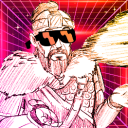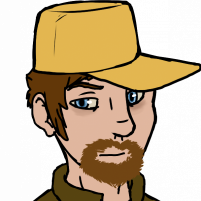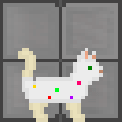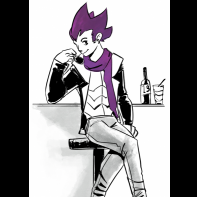Leaderboard
Popular Content
Showing content with the highest reputation on 10/28/2018 in all areas
-
Field Report A-4: The NSS Ragnarok, "Shade in the Sun" & the "Jack Lean Incident" The NSS Ragnarok is one of the oldest, still operating installations in NanoTrasen's roster, its inaugural shift occurring in 2298, and the facility itself undergoing extensive structural modifications, architectural redesigns, and even a full conversion to a Plasmaman-only atmosphere for the sake of a three year-long societal study, which ended in the deaths of 76 individuals and the still-active Hanson Edict, which forbids hiring any Plasmaman individuals for work aboard stations with a Security Clearance Level of Delta or above. Nonetheless, the Ragnarok remains as one of the crown jewels of the company's research stations, and continues to produce extremely valuable research data pertaining to Bluespace, theoretical mega engineering and experimental bio-augmentation technology (notably, the first instance of the "Hulk" gene being spliced into a sentient humanoid occurred on the Ragnarok... with disastrous results). It is, therefore, not surprising that Inquiry Team B-9, codenamed "Shade in the Sun", was based on the station, seeing as it was one of the few locations capable of producing Bluespace Interdiction Alloy. This Alloy's name is somewhat misleading, as it isn't, in itself, an alloy of multiple metals; instead, it is simply lead that is, and I'm reading off a company primer here, "infused with raw Bluespace energy via a proprietary, revolutionary smelting technique". What this actually means is entirely unknown, as the secret "recipe" behind the creation of BIA is known only to select few individuals within NanoTrasen's company structure and, to the best of our knowledge, no other entity has successfully reverse-engineered the process via material analysis. However, what is known is that every facility that produces BIA is also heavily involved in the study of Bluespace itself, which might indicate that the lead metals are, in fact, subjected to Bluespace "energies", whatever that might mean. Regardless, the end result is the same: a type of "metal" that can be used to stop the movement of creatures and sentients that utilize Bluespace shortcuts to travel long distances in Realspace. It is unknown to me how this process works, but it appears it can only serve as a cage in actual practice; a Bluespace-connected creature can easily move around it, but cannot leave its interior. This is the standard containment protocol for Xenos Sanguis ("Vampires"), Xenos Umbra and captured SWF personnel. The Ragnarok itself currently counts seventeen holding pens with as many Mark VIII BIA Containment Box units, twelve of them containing Xenos Sanguis specimens, and the remaining five holding Xenos Umbra specimens. It is here that NanoTrasen currently sends all known captured specimens of the latter species, with existing individuals in containment being terminated via an in-built mechanism that produces a bright flash of light, approximately 300,000 Lux in intensity, for a duration of ten seconds; this is enough to not only kill the specimen, but reduce the body to a harmless pile of ash with minimal distortion fields around it. Despite this, the facility has produced very little information regarding the creatures, as, unlike Xenos Sanguis specimens, Xenos Umbra individuals consistently display a complete refusal to cooperate (or, in fact, communicate at all in some cases), as well as a pronounced security risk due to the complicated methods required to keep them contained for experimentation (compare and contrast Xenos Sanguis specimens, who only require a sip of blessed water to be rendered mostly harmless). On multiple occasions, captured specimens simply refused to move or communicate for long periods of time, only to escape the moment a breach occurred in the Containment Box, regardless of how minor it was, suggesting not only a propensity for "playing the long game", but also a well-developed ability to serve as ambush predators, being capable of lying in wait for long periods of time before exploiting the flimsiest of opportunities to strike. This might offer some clues as to how infection occurs to begin with. Nonetheless, Inquiry Team B-9 "Shade in the Sun" began operating off the NSS Ragnarok shortly after the end of the New Langdon Infestation Event. Initially composed of only three Bluespace Xenobiology experts, the team quickly grew to acquire several more key company individuals, including the esteemed Dr. James Woolworth, Dr. Ruth Lancaster, and the ever-controversial SWF Liaison Kingsley Grizwold (whose presence was requested at the insistence of then-CEO Timothy Heeren, due to the SWF's deep involvement with Bluespace and their still-not-well-understood eagerness to cooperate with NanoTrasen in containing the Xenos Umbra threat). B-9's assigned task was to acquire as much information as possible about their subject matter: biology, behavioral habits, Bluespace-related abilities, sentient subversion process and, of course, methods to combat the creatures in practice that could be distributed and disseminated via Standard Security Training Programs (SSTPs), which had, up until that point, been lacking in terms of how to fight these creatures in the case of any surprise infestation. While the existence and expansion of "Shade in the Sun" marked the beginning of a shift in company attitude towards these creatures, the team's initial activities were still classified under Authorization Level Epsilon+, and even today I was not given access to them, even for the purposes of this field study. The only available records, themselves still classified under Authorization Level Delta, are those produced after Work Shift 462.87.4 in 2500, heretofore referred to as the "Jack Lean Incident", the incident itself classified under Authorization Level Epsilon, and having taken me several days to obtain clearance on. This odd name was assigned by then-on-site Chief of Security Jack D. Lean, who was awarded the NanoTrasen Medal for Distinguished Conduct and "Robust Security" Award, then offered the Captaincy of the Ragnarok for his role in saving the facility during what can only be described as a state of siege that erupted during the course of that shift, and lasted for an almost unbelievable seventeen days, involving five different Red-Level Emergency Response Teams, three different Gamma-Level Emergency Response Teams, and required the hitherto unheard of activation of Asset Protection Squad "Black Rose", the existence of which forced NanoTrasen to publicly disclose the existence of what were later decried by SolGov as "company deathsquads". The "Jack Lean Incident" itself was so immense in its scope that NanoTrasen feared it would leak out and potentially end up in headlines across the galaxy; it placed the company in an almost impossible position: either publicly admit that they were aware of the existence of Xenos Umbra specimens in a PR-friendly way and hope the backlash was manageable, or continue with information suppression and not only risk having it be leaked anyway, but also risk a repetition of the event at other locations. In missives exchanged between the surviving members of B-9 and then-CEO Daniel B. Simmons, the former advised the latter that full disclosure was preferable, as it would help prevent further disasters in the future. Simmons acquiesced, and NanoTrasen made the now-famous "Stanton Declaration" at the Galactic Forum (so named due to the choice of Forum Representative being John Stanton, a man famous for consistently being the company's bearer of bad news for the entire length of his career). The "Jack Lean Incident" involved not only the aforementioned facility and ERTs, but also direct fire support from the NDV Kraków Heavy Cruiser, the NDV Sinister and NDV Tomahawk Support Cruisers and legendary NDV "Hammer of God" Superheavy Battleship, logistics support from the NRV Phobos Transport Barge, medical support from the NRV Humilitas Hospital Ship , as well as several dozen smaller vessels providing food, medication and ammunition from the nearby NCS Providence, NSS Odin, NMB Stellar and NXS Amazon (whose particular brand of Bluespace-infused mutant tomatoes were noted as "supremely useful" by CoS Jack Lean). Due to the survival of the station, and the fastidious nature of the on-site Security Staff's record keeping, there is a surprising wealth of information on the full timeline. Work Shift 462.87.4 begins without any complications or staff complaints; simultaneously, Inquiry Team B-9 begin organizing their next General Meeting, whereby members of the team would exchange all information gathered since the last one (which, at this point, was non-existent, as it had been for several of the last cycles). One of the members, Dr. Curtis P. Pendleton, is noted as having arrived late and in a state of noticeable sleep deprivation, which they explained as being the result of a poor reaction to "shitty cantina burritos", which had resulted in prolonged bouts of vomiting and extreme gastrointestinal discomfort. Dr. Pendleton is advised to return to his assigned living quarters and seek medical attention, but refuses, stating they had already contacted on-site medical personnel and acquired some stimulants which would help them function properly until the shift was over. B-9 is reported as being highly suspicious of this, considering the shift had barely begun, and another one of its members, one Dr. Cassandra L. Wellington, suggests calling on-site Security forces due to suspicions of drug usage. Dr. Pendleton becomes agitated at this point, and requests Security staff not be called; this leads to a minor scuffle when Dr. Wellington attempts to activate the intercom, ending in them being knocked unconscious, three other individuals present being severely injured, and Dr. Pendleton running into the nearest maintenance tunnel. Due to the nature of B-9's studies, Chief of Security Jack Lean is immediately contacted. Code Red is declared approximately five minutes later, and CoS Lean convinces on-site Captain Horatio Smith to broadcast an alert to the station that "hostile xeno organisms" were on the loose. All maintenance tunnels are locked and bolted down, staff are ordered to remain within their departments and the on-site Armory is unlocked, its contents distributed to on-site Security staff. Immediately afterwards, the NAS Peabody (attendant administrative station to the Ragnarok) is alerted, and an Emergency Response Team is requested. CoS Lean leverages contacts in company structure to authorize the activation of ERT Hispania-9, a Red-Level Emergency Response Team specialized in combating Xenos Mutatio specimens (so chosen due to the very real threat of deadly melee combat). Hispania-9 arrives on station ten minutes later. Despite the extremely heavy-handed and lightning-fast response, as well as the genuinely astounding organizational and leadership skills displayed by Captain Smith and CoS Lean, Dr. Pendleton is never found before he "hatches" into a Xenos Umbra specimen. Unlike all other examples of infestations, the new specimen, heretofore referred to as U-P, was heavily talkative over the radio, condemning NanoTrasen's actions and promising anyone who would join them a "glorious rebirth" in "the Father's embrace". Despite the best efforts of the facility's AI Unit, the location of the radio signal is never positively triangulated for suppression, and, fearing what a telecommunications lockdown would do to Security staff cohesion, CoS Lean allows communications to remain active. This results in several incidents of personnel attempting, and often succeeding, in breaking into the maintenance tunnels, only to be immediately captured and subverted by U-P. What followed for the remainder of the standard shift's duration was what was described as a "game of cat and mouse" by on-site Warden Ruum-Voo Tuuurl, whereby Security staff, in coordination with Hispania-9, would organize a raid of the maintenance tunnels, apprehend several thralls, lead them to on-site medical personnel, remove their frontal lobe tumors, and then be saddled with further personnel who were either captured by U-P or deliberately sought it out. At the end of the standard work shift, Captain Smith and CoS Lean message the NAS Peabody and request a transfer shuttle not be sent until the on-site threat had been properly handled. The situation on the Ragnarok deteriorates over the next several hours, as attrition begins to take its toll on on-site Security forces and other personnel. The number of thralls begins to steadily increase as the facility's ability to respond to U-P begins to wear down and fail; eventually, Security staff transport the remaining contents of the on-site Armory to the Engineering Bay, setting up a field hospital and using the department's proximity to the Ragnarok's Medbay to quickly transport captured thralls for surgery. Despite still retaining the ability to strike out from these two departments for a few hours afterwards, non-thralled staff are eventually reduced to erecting improvised barricades and barriers, and fending off repeated assaults from thralled personnel; this included the usage of several high-powered floodlight units, and a complete barricading of the maintenance tunnels that linked Engineering to Medbay, which were a focal point for U-P's direct assaults, and served as the "field headquarters" for CoS Lean for the duration of his namesake event. Due to the dwindling number of active, loyal staff members, CoS Lean orders that all captured thralls be given a Mindshield Implant after surgery, in a desperate bid to stymie further subversion; records indicate that application of the implant, while useless at halting the thralling process itself, provided individuals with the ability to resist U-P's calls over the radio. Eventually, after 24 hours of active siege, CoS Lean and Captain Smith, together with Hispania-9, storm the Bridge, capture three thralls and severely injure U-P; however, the main purpose of the raid had been to reestablish communications with the NAS Peabody. Immediately after this is done, a short briefing is provided, and a request for emergency aid is sent. The NRV Humilitas is sent to tend to the wounded (thanks to its on-board teleportation suite), escorted by the NDV Sinister and NDV Tomahawk. Concurrently, Emergency Response Teams Scythia-1 and Britannia-15, two Red-Level ERTs, are activated, quickly followed by two more Red-Level Teams, Aegyptus-11 and Cartago-8, along with Gamma-Level ERTs Zeta-3, Beta-27 and Iota-50. At this moment, CEO Daniel Simmons declares the NSS Ragnarok "Priority Defense Epsilon", indicating it was to be defended at all costs, and only destroyed if all on-site personnel were dead and/or subverted. The siege had begun. Fighting continues aboard the Ragnarok over the course of the next two weeks, with the siege escalating until the remainder of the noted support vessels and associated facilities are involved. Improvised docking bays are constructed out of scaffolding and spare construction materials to allow smaller vessels to bypass the use of the standard docking bays, which had been lost to thralled personnel, and the field hospital constructed in Engineering is eventually expanded to include two relocated Surgical Operating Rooms in order to ensure the safety of valuable medical personnel. Simultaneously, several dozen shipments of Mindshield Implants are issued to the NSS Ragnarok, and CoS Lean issues a command for all dethralled personnel to be issued one after surgery is complete. Slowly, combined on-site and ERT forces begin to push back against U-P and subverted personnel, until the former is once again forced to retreat to the facility's maintenance tunnels, and NanoTrasen-loyal staff regain control of all vital areas of the station. Local command center is shifted to the Ragnarok's Bridge, and continuous communication is established with the NAS Peabody; due to the extended siege and amount of damage caused during it, as well as the extended duration of operations, Asset Protection Squad "Black Rose" is dispatched as an emergency measure. Approximately three hours after activation of "Black Rose", U-P is found, terminated, and its body cremated. The "Jack Lean" incident is unique in its scale, as it showed what even a single Xenos Umbra specimen was capable of; Dr. Pendleton was fully aware of not only the station's layout, but of all information gathered by NanoTrasen in their studies of the creatures, allowing them to act in hitherto unknown ways in order to confuse on-site Security forces, such as subtle brainwashing via radio, use of active siege warfare instead of quiet subversion, and somehow managing to avoid creating any of the electrical and power issues common in just about every other recorded instance of active infestations. This incident also cemented NanoTrasen's belief that Xenos Umbra specimens were parasitic lifeforms; Dr. Pendleton had been a respected NanoTrasen employee for close to thirty years before "Jack Lean", and never exhibited any traits associated with infection until the day of their transformation. Additionally, it conclusively proved that newly born specimens retained information known to their hosts, indicating a semi-symbiotic relationship between the two. It was also a turning point for company policy, not only in regards to information distribution, but also attitude towards the creatures: from that point forward, standing orders would be to fight off any infestation to the last possible moment, rather than eliminating infested locations preemptively before an Ascendance Event took place; which makes "Jack Lean" even more unique, as the Bluespace distortions recorded by long-range scanner arrays were on the level commonly associated with such Ascendance Events, and yet, no such one took place, seeming to indicate that Xenos Umbra specimens can voluntarily prevent such cataclysmic events from taking place; U-P appeared to want to break down the command structure via subverting the entire crew of the Ragnarok, and though Bluespace distortion levels were so high that at times they impeded long-range communication from even reaching the station, no such Ascendance happened, suggesting that, perhaps, the parasitic lifeforms are capable of independent, goal-directed behavior outside the standard observed path. This is extremely worrying, as U-P demonstrates that such specimens may very well eschew their Ascendance for the sake of psychological warfare on a grand scale. On a more positive note, "Jack Lean" also conclusively proved the effectiveness of Mindshield Implants at providing passive resistance to subtle, potentially Bluespace-influenced, brainwashing, though NanoTrasen has yet to develop a model that can resist the creation of the frontal lobe tumor associated with the process of "thralling". Further research is required. Signed, Quincy D. Huxley ENG LOG.3 points
-
While I disagree that what I proposed would make it irrelevant fluff I can't disagree with the extra form of grief and abuse that would follow since it is inevitable you'll get individuals who try to game the system at the expense of others. Maybe one day we'll have those nice things...1 point
-
I can agree that without persistence there isn't a scarcity of resources however I'm not speaking about establishing an actual economy in which there is a definitive supply and demand where a scarcity would drive up prices of resources while a surplus would drive down those same prices. Perhaps I'm misunderstanding the point you're trying to make but what I'm suggesting is a simple method for making credits more relevant than what they currently are. Introducing an artificial demand for key items (in this instance medkits) isn't necessary, its just slapping prices on items that individuals outside of those departments they can be found if they do not wish to go through the proper channels to obtain them. Medkit on the bridge empty? Better go over to Medbay spend a few credits to restock the kit. Want some unstable mutagen for Botany? Better pull out your wallet to pay for some from Medbay or SciChem. Its just a fledgling purpose for the use of an item that at the moment really doesn't have much of a use outside of roleplay purposes and even then very rarely, or entertainment purposes in purchasing items from the cargo console, or playing the slots if you're really bored. While the idea of having a bank account that rolls over from round to round would be wonderful it simply shifts the balance in favor of those who can regularly play as opposed to those who can't and would further the argument against giving the credits a purpose beyond what they already serve now since to slap a price tag on items would suddenly make it all the more unfair for those who can't save up credits in a timely fashion to get goodies and in the end turn them off from playing the game all together.1 point
-
So the problem, is that as we appear to be defining it, an economy exists to allocate scarce resources. A non-persistent economy, does not do that, effectively all it would do would be to limit how much of a resource someone could get in game. Yes, it would. But in doing so, its not so much a fairer distribution of resources, so much as it is a random distribution. I think any efforts to make an economy without persistence are a waste of time and effort. Without persistence, resources are not scarce except for perhaps immediately scarce for that round. Without any sort of actual (persistent) scarcity, we would have to significantly introduce scarcity by artificially reducing supply of key items for any of the changes to have a meaningful effect. (Station gets two medkits)1 point
-
Rather than having a persistent economy where your bank account rolls over to each round, what about a simple economy where there are set prices that are unaltered for products that are charged to personnel outside of the department with the same randomly generated bank account system that is given at round start modified with a paycheck based on the job that is selected that is deposited into the accounts every half hour of the round. All charges for products don't go to the individual's personal account but instead go to the department account which can be used for the benefit of the department or the employees within at the discretion of the head of that department. The request console can be used to order something from cargo and instead of using up Supply Points there can be a choice to pay for it from the Department's Account with the order being recorded in the Accounting System which can be reviewed by the Head of the Department. In the sense of how it could be implemented through such departments like Botany, place fridges that can be loaded and would pre-set a price for the product itself that can then be obtained by whoever wants to pay for the product so long as they have the funds to do so, whereas intradepartmental acquisition of resources like between the chef and the botanist are completely waived since the resources acquired would be for that department's use. That will prevent an unfair advantage that come from players that can sink more time into the game than players who can only spend perhaps a round every other day playing since the bank accounts are reset with each round. It will curtail the problem of painting targets on the back of individuals who accumulate a great deal of wealth since the wealth accumulated would be based entirely upon the job that is being performed, those with the biggest targets on their back being members of command who shouldn't be in a position where they'd have their information/ID stolen to begin with. It would resolve the meta/grudge problem since as before, there isn't a great deal of wealth centralized in any one place since the accounts themselves are still randomly generated. The self-antagging is a simple resolution as a simple modification of Space Law to either include the stealing of a certain amount of money to fall beneath 'Petty Theft' 'Robbery' ' 'Theft' 'Grand Theft' or you could even create a new category specifically for the theft of funds from the station. In order not to allow the HoP to get away with the crime completely free, allow the Heads of Departments the ability to see and manage their department's accounts along with the Head of Personnel so there isn't just a single individual with control of the information. In this way we can make credits more relevant in the game without completely breaking the current system. A slight modification to the slot machines either increasing the cost of the credits used or cap the maximum payout to 10,000 credits with the same percent chance as winning 100,000 or even 1 million credits so it still encourages the use of the slots without entirely breaking the balance. I think focusing on a simple framework for an economy instead of trying to tape on a framework that would introduce more problems than solutions to the current issue would be the best course of action in this sense. Then later as it becomes solidified and the bugs are worked out of it we can introduce different aspects of the economy and make it a bit more in depth than what we started with.1 point
-
1 point
-
1 point
-
1 point
-
Not a screenshot but a letter from a prisoner in perma. I feel like these always deserve a post because so few get to actually see them.1 point
-
Field Report A-3: The New Langdon Infestation Perhaps one of the most curious events related to the Xenos Umbra was the massive infestation that took place in the colony of New Langdon between the years of 2487 and 2489; these three years, while taking a severe toll on the population in terms of physical and mental exhaustion, allowed NanoTrasen researchers and security personnel to observe and register novel behavioral patterns, chart the progression of individual power of these creatures, and first begin true inquiry into the nature of the individuals subverted by the species, commonly called "thralls". The colony of New Langdon was officially founded in 2315, on a planet christened Nuova Roma, located in the Sigma-17 binary system, and funded almost entirely by NanoTrasen, with minor contributions from private investors securing transit in the colony ship. The entirety of the population was gathered from Mars, and the new colony was to serve as an innovative, long-term commercial venture by the since-defunct NanoTrasen New Worlds Project (initially established to fund and exploit colonial ventures, but shut down in late 2425 due to rampant corruption in the administrative staff and "gigantic monetary losses" in its operation). Its initial population amounted to 5000 individuals, with more being encouraged to migrate with financial incentives and company care packages; many were relocated from NanoTrasen housing facilities to planet-side domiciles, in order to boost the population numbers. Curiously, no Bluespace research, or indeed any company-related research, was ever conducted on New Langdon, making it puzzling as to why an infestation took place in this location. Colony development is uneventful and proceeds in accordance with expected models for most of its existence, until the year of 2487 rolls over and, over the course of the first few months, a familiar pattern emerges: increased failures in the electrical infrastructure, powergrid malfunctions coupled with higher-than-average occurrences of brownouts and blackouts, and a gradually increasing number of medical complaints related to insomnia, night terrors, vivid nightmares and heightened aggression. Seeing as NanoTrasen were, at this point, already aware of the existence of the Xenos Umbra, a team of specialists was dispatched, headed by one [REDACTED]. How unfortunate. The team is listed as having been composed of seventeen Xenobiologists, fifteen security personnel armed with a surprising amount of weaponry, and a company representative meant to serve as a liaison between the team, the local colony council and the NAS Sirius, the closest NanoTrasen administrative center. The team was officially designated "Jackal Sierra", and acted mostly independently from any other entity, under the leadership of Representative [REDACTED]. Over the rest of 2487, "Jackal Sierra" worked extensively in coordination with the colony council in the installation of a newer, more distributed energy grid, training of law enforcement personnel and distribution of select amounts of classified information meant to better prepare the population for what might possibly be a public calamity of unseen proportions; with no prior incidents of Xenos Umbra infestations in large population centers, it was impossible to know what the end result would be. While it had been hypothesized that a hard "cap" existed to the amount of power one specimen could accrue before an Ascendance Event took place, no experimentation had taken place to find a definitive answer; and regardless, an Ascendance Event taking place in such a location would be a catastrophic disaster, one that would not only force NanoTrasen to publicly acknowledge the existence of the species, but would also most likely bankrupt it with the sheer costs of repaying the investments made towards New Langdon and the life insurance payoffs towards the surviving family members of anyone on the planet at the time. However, such an hypothesis would be quickly put to the test when the first confirmed sighting of a Xenos Umbra specimen was confirmed in a sewer system in late 2487, with members of "Jackal Sierra" initiating pursuit but losing track of the creature and falling back to their field HQ. After this sighting, Representative [REDACTED] issues a single message to the NAS Sirius: The wording used seems to indicate that "Jackal Sierra's" objective was not so much to help contain the infestation, but to chart its progress for the sake of increasing the knowledge pool on this species of parasites, potentially at the expense of the local population. While I cannot tell for certain, it would be consistent with future decisions made by NanoTrasen, and the relative success of the New Langdon infestation study most likely contributed to increased risk-taking on the part of the company. But I digress. Over the course of the next few months, a curious phenomenon began to arise: the number of sightings of Xenos Umbra specimens began to rise more quickly than expected, far more than what would be possible with a singular entity infestation like NanoTrasen had seen before, until, in mid 2488, "Jackal Sierra" confirms the existence of a second entity, followed by a third one three weeks later, a fourth one two weeks after that, and twelve more over the week after that. The research team's records seem to indicate a heightened state of alarm, and the number of confirmed specimens was never revealed to the colony council, instead being reported directly to the NAS Sirius; in response, NanoTrasen authorizes the activation of ERT Lambda-7 (Code Name: Last Out), their finest Gamma-level Emergency Response Team, only used in extreme, company-threatening circumstances. Lambda-7 immediately scrambles to New Langdon a mere ten minutes after activation, and sets up a secondary field HQ next to the existing one manned by "Jackal Sierra". Here, the operation takes on different, and slightly bizarre contours, with "Jackal Sierra" and Lambda-7 apparently working both in tandem, and independently, with the former attempting to capture and study live thralls and Xenos Umbra specimens, and the latter overseeing police and military training, weapons distribution and powergrid reinforcement efforts, along with leading occasional raids into suspected thrall hideouts. It is also noteworthy that, despite the number of active specimens, and the population of the colony exceeding 50,000 individuals at the time of the infestation, no more than fifty simultaneously extant thralls were ever positively identified, and the amount of Bluespace distortions that could be verified by long-range scanners barely diverged from expected, background values. Despite this, "Jackal Sierra" acquired a number of thralled individuals for study (in fact, the very first recorded use of the word "thrall" dates back to this infestation, as a means of classifying general behavioral patterns), using them as test subjects in a myriad of ad hoc tests designed to testevaluate motor function, logical thinking and emotional intelligence; curiously, while the first two remained unaffected when in comparison with unaffected members of their species, individuals thralled by Xenos Umbra specimens exhibited traits commonly associated with sociopathic individuals. Additionally, while upper brain functions remained unaffected, thralled individuals were often spotted undergoing long periods of starvation and general deprivation in order to accomplish goals presumably set by their parasitic host, with seventeen recorded cases of death by starvation, and twelve recorded instances of death by dehydration. It is also here that NanoTrasen first becomes aware of what causes the process of thralling to begin with, with MRI scans of affected individuals revealing large, tumorous growths seemingly "attached" to their frontal lobes, presumably a means for the parasitic organism to enforce its influence onto the subject's conscious mind. Much like Xenos Umbra specimens, these tumors were highly sensitive to direct light, and would quickly shrivel and melt into undifferentiated cell matter upon being exposed to direct lighting for more than a few seconds. This is also when the first recorded instances of "de-thralling" took place, and the New Langdon infestation served as the field manual for emergency "de-thralling" surgery. Eventually, in late 2488 and early 2489, Representative [REDACTED] receives a series of orders from the NAS Sirius ordering the end of any field observations, and mandating the termination of all confirmed active specimens. Over the course of the following months, Lambda-7, in conjunction with local police and military forces, launch a series of strikes against known hotspots, culminating in the destruction or capture of all known Xenos Umbra specimens, all of them terminated and subjected to intense sunlight for a period of no less than three (3) hours. The surviving corpses were encased in concrete and shipped to the NAS Sirius, where the trail grows cold. All company operations related to the Xenos Umbra threat cease in mid 2489, with no further reported cases of Bluespace distortions or infestation from the colony. Lambda-7 is officially recalled, as is "Jackal Sierra", as New Langdon celebrates Victory of Light Day. The New Langdon infestation is curious, as it never quite progressed to any level close to an Ascendance Event, despite the number of active specimens and simultaneously extant thralls. This seems to indicate that the progression of power required for such a thing to occur is fluid, rather than static, and perhaps even linked to the population size of the infestation site, which opens up a series of interesting hypotheses. Nonetheless, the infestation also informs us on NanoTrasen's increased interest in the creatures, what lengths it would go to in order to prolong an infestation to study it, and what it would do with such information; emergency "de-thralling" procedures would, from that point forward, be included in a small package of classified information reserved for on-site Captains for NanoTrasen installations, to be used at their discretion, and a series of missives from company HQ in Sol indicate the establishment of a special sub-division of NanoTrasen's Xenobiological Research Division dedicated entirely to locating and studying Xenos Umbra specimens. This sub-division, aptly code-named "Shade in the Sun", was based on the NSS Ragnarok, and continues to operate mainly from there to this day. This is my next destination. Signed, Quincy D. Huxley END LOG.1 point
-
Field Report A-2: The NSS Discovery Incident The NanoTrasen Science Station Discovery remains as one of the company's darkest and most well-hidden mysteries, one that remains secured behind Authorization Level Epsilon to this day; I myself was only authorized to peruse through existing logs due to the nature of my investigation, and even then was forbidden from directly quoting any part of them, being forced to utilize indirect references and "close-enough" paraphrasing. With construction beginning in 2401 and ending in 2432, the NSS Discovery was the first in a new series of research station design iterations that would eventually culminate in the Cyberiad-Pattern Research Station design. The Discovery was set to become the very first NanoTrasen-owned installation dedicated entirely to Xenobiological studies. To that end, it was equipped with multiple decks of reinforced containment cells, several high-tech Hydroponics units and approximately three times more weaponry and riot control gear than most other research installations extant at the time of its inaugural shift. Its final location was chosen to be the Tau-56 system, located in the far reaches of the Tau Fringe, next to a star cluster notable for its high incidence of Earth-like planets inhabited by unique fauna and flora. It operated from 2432 to 2498, after which it was officially declared "Missing Under Suspicious Circumstances". The loss was designed as "Category C", ostensibly standing for "Catastrophic", considering the amount of resources and personnel invested into the facility. While officially NanoTrasen has never provided a reason for the Discovery's disappearance, the "unofficially accepted" explanation is that it was destroyed via unauthorized activation of the on-board Nuclear Failsafe Device, ostensibly installed in order to prevent hostile takeover by the part of any hostile entities, sentient or not. However, the few records that do exist in regards to the Discovery do not support this hypothesis, as no radiation bursts were detected from its last known location, and no debris belonging to the station was ever found. For all intents and purposes, the station disappeared, and was not simply destroyed. However, the last two shifts recorded as having taken place aboard the NSS Discovery shed a light on the most likely reason for the facility's vanishing: a successful Ascendance Event. Approximately sixteen hours before all communication with the Discovery ceases, the second-to-last ever shift begins with no incident. Research into captured Xenos specimens continues as programmed, with only a few minor scuffles reported by on-site Security staff, ostensibly over a "rigged" arcade machine that on-site Engineering staff had installed in the cantina. However, approximately eleven hours before communications cease, just beyond the halfway point of the shift, several abnormalities in the station's power grid are reported, with several departments issuing formal complaints with the on-site Chief Engineer, one James Blasky, over the constant brownouts experienced by the crew. No abnormalities with the Singularity Engine are reported, and Engineering officially explains the power grid failures as being the result of faulty wiring. Despite extensive repairs over the course of the rest of the shift, powergrid issues persist without being resolved, and Chief Engineer Blasky officially faxes the NAS Karakorum (attendant administrative center to the NSS Discovery) requesting the following shift be equipped for more in-depth repairs of the grid, including potential SMES unit replacements. The rest of the shift proceeds without other incidents. However, at the beginning of the following (and final) shift, the NAS Karakorum issues a notification to the NSS Discovery, warning on-site captain, Melinda Bernstein, that a crewmember from the previous shift, one John Berkeley, never reported at the end of their work period, and that a full search of the station was mandatory in order to ascertain their whereabouts. Captain Bernstein indeed orders on-site Security staff to search the station for Mr. Berkeley, to no avail. Powergrid issues persist, and in fact worsen throughout the first half of the shift, until an odd report on the part of the on-site Cook has Security staff investigate the walk-in freezer, where they find multiple slabs of meat missing, along with one of the back doors being hacked open. Security is unable to follow any trail, but comms chatter logs indicates that Security staff suspected it was the work of the missing crewmember. Approximately three hours before communications cease, all lights within the Medical Department simultaneously fail, plunging the area into darkness for approximately ten minutes before Engineering staff respond with enough replacements. All contact with medical personnel ceases past this point, and Medbay goes into lockdown. On-site Security staff respond by issuing an arrest order for the on-site Chief Medical Officer, one Andrew Adams, and issuing Riot Control gear to multiple officers. Approximately two hours before communications cease, the NSS Discovery's powergrid shuts down, plunging the station into complete darkness. On-site Engineering staff do not respond to this, claiming they were evacuating and citing multiple encounters with hostile entities in the maintenance tunnels around Medbay and within the department proper. Command-level comms chatter is rather confusing, and it seems that the administrative staff was never quite aware of what was happening, believing the situation to be some sort of mutiny, up until approximately one hour before communications cease, when Captain Bernstein issues a request for an Emergency Response Team, citing an infestation by unknown lifeforms that had, to their best of their knowledge, consumed most of the Medical and Engineering staff. The NAS Karakorum scrambles ERT Gallia-15, a Red-Level Emergency Response Team composed mostly of close combat specialists and accompanied by three medics. Upon boarding the NSS Discovery, approximately 15 minutes before communications cease, Gallia-15 reports that all on-site comms chatter has died down, and that none of the facility's electronics appeared to be functional, the team being forced to use emergency crowbars to force open depowered airlocks in order to progress. Gallia-15 reaches the Discovery's Bridge, only to find it empty, and the Captain's office ransacked. Gallia-15 reports this to the NAS Karakorum, presumably the reason why an unauthorized nuclear activation is believed to have been the cause for the disaster, the on-site Authentication Disk being missing. At this point, approximately 5 minutes before all communications cease, Gallia-15 reports a loud scream that seemed to be audible throughout the entire station. Following this message, Bluespace distortions severely compromise communications with Gallia-15, with the last few words audible in the logged recordings speaking of red eyes, Bluespace teleportation and large mobs of brainwashed crewmembers. Eventually, all communications with Gallia-15 cease, and no further messages are received from the NSS Discovery from that point forward. With no further information to work with, the NAS Karakorum authorizes activating ERT Mercury-3, a Gamma-Level Emergency Response Team. Mercury-3 would deploy to the last known location of the Discovery, only to find all traces of it had disappeared. Despite searching the Tau-56 system and surrounding star cluster, no signs of the station, or debris belonging to it, were ever found, and NanoTrasen officially files the "Missing Under Suspicious Circumstances" notice 3 standard days later, followed by classifying all information pertaining to it as Authorization Level Epsilon, despite the lack of any hard evidence concerning any tangible, known threats. However, NanoTrasen's actions betray an already budding interest in the Xenos Umbra threat, as the disappearance of the Discovery occurs several years after the company was made aware of the species' existence, and follows many of the patterns exhibited by known and recorded Ascendance Events, such as frequent powergrid issues, lighting system malfunctions and progressive subversion of the crew, in addition to frequent mentions of red eyes and brainwashing, not to forget the massive amounts of Bluespace distortions both reported by Gallia-15 and recorded on long-range scanner arrays. This seems to indicate that early action taken towards these creatures involved an attempted suppressing of information, rather than dissemination and study. To this end, I will need to attempt to identify similar attempts at censoring vital information, and seeing where they may lead me, then attempt to ascertain what caused a shift in attitude towards these creatures, seeing as modern NanoTrasen policy both acknowledges the existence of the creatures, and actively encourages its research divisions to acquire as much information as possible about them. Signed, Quincy D. Huxley END LOG.1 point
-
@FursamieI've actually done this very Umbra thing before, but ended up dropping it after it got too noodley for my taste. I've since decided to reboot it properly and use what experience I've gained in writing to make it a more streamlined and palatable narrative. And yes, the thought of similar reports on other creatures has went through my mind, potentially Changelings as a first experiment.1 point
-
Field Report A-1: Resource Acquisition Site Romeo-19 While the shuttle I've been assigned is anything but comfortable, it does the job it was designed to do. As I was informed, it possesses all the amenities required for a long-term field study, as well as the facilities necessary to keep me alive and well-fed for the foreseeable future. On a further positive note, a fully furnished and supplied Autolathe and Cyberiad-Pattern Protolathe have been installed on a last minute recommendation by the overseer assigned to pre-flight maintenance; this should mean that if I do not possess a tool for the job at hand, I can simply make one. This will most likely make things extremely simpler, as the stylish sunglasses I'm now wearing most definitely prove. Nevertheless, I digress. The first officially recorded contact with a Xenos Umbra specimen occurred in 2389, though previous, unrecorded encounters have not been ruled out at this moment (it being likely that, given the apparently supernatural abilities of these creatures, precious encounters may have been passed down through tales of "Shadow People" present in various cultures across the galaxy), in Resource Acquisition Site Romeo-19, my very first destination. It is currently a sprawling industrial complex built around a city-sized asteroid, and located within the asteroid belt surrounding CHA-12312B, the G-class star of the Lambda-15 system. Its current assigned goal is the exploitation and strip-mining of the asteroid belt, and it currently produces mostly Titanium and Plasteel for delivery to the Tau Fringe and the Omicron Core Worlds. However, at the time of First Contact, it was little more than a series of hastily-pressurized habitation blocks connected by umbilical tubes that were prone to failure and malfunction, something that cost the lives of 37 personnel during the initial construction period, which lasted from 2387 to 2391. Full mining operations only began in 2493, and expansion of the facility only began in earnest in 2446. The encounter with the specimen, heretofore referred to as U-1, is therefore poorly logged in company records, having occurred in a barely functional construction site staffed entirely by low-grade miners and only a half dozen trained engineers. For this reason, I have traveled to the complex myself, where I met with Chief Engineer Aaron Kemsley, current on-site Chief of Operations. Thankfully for my research, on-site records have been well kept in backup hard copies, and Dr. Kemsley permitted me access to the databanks for the duration of my stay. The findings, while minuscule in comparison with future ones, nonetheless shed a much-needed light on the early history of NanoTrasen's involvement with these creatures, and their methods (or lack thereof) to combat possible infestation. Anomalous reports first began appearing in early 2388, with the construction staff reporting multiple power outages, unusually frequent light fixture malfunctions and, eventually, high incidence of migraines, insomnia and nightmares in the staff. As the situation degraded, and multiple individuals began issuing formal complaints with the site's engineers, then-current Chief of Operations, one Michael Brattis, requests emergency medical aid from the NCS Venture, the nearest NanoTrasen installation, located in the Lambda-13 system. Due to the relative unimportance of the construction site at that time, along with the lack of trained medical personnel on-board the Venture, the request went unheeded for approximately 3 STT (Standard Terran Time) months, during which the medical condition of the construction staff deteriorated further. Eventually, as a team of emergency medical personnel arrived, the continued operations aboard Romeo-19 were deemed unfeasible; on-site Staff were evacuated and construction was halted until a replacement team was found. The original crew, which had been working on-site since the start of the construction process, made a full recovery, but refused to return, citing "horrible things" happening to them in their sleep, but refusing to elaborate further. The trail grows cold, as the records proceed to the next staff rotation. Is it notable that NanoTrasen does not seek to investigate these complications further, as no reports of further inquiries into these medical conditions are logged. The issues present with the first rotation carried on with the second one, with early 2388 logs reporting a much quicker-acting onset of nightmares and night terrors, along with several incidents of miners disappearing during work hours and reappearing several hours later with little to no memory of the time lost. One of the miners, one Robert Proudhon, would never return, though his corpse (or what became of it) would be found later (see below). This would carry on throughout the following standard weeks until, at a certain point, on-site Chief of Operations Sarah Carver sends the following message to the NCS Venture: The records show the reason for this message: earlier in the work shift, one of the mining teams reports spotting an "unidentified creature" in one of the deeper mining tunnels. One of the miners reports having spotted a "hole full of resin", which was quickly ordered to be torched. What happens afterwards is unknown, but the next communication arrives approximately 5 minutes later, with the mining team reporting having killed a "black humanoid thing", specimen U-1, which was quickly dumped into a deeper tunnel. After evacuating the mining site and sealing the entrance, construction is once again halted until reinforcements from the NCS Venture arrive. Further expeditions into the mining tunnels revealed that the resin was made of an hitherto unknown material, and that the corpse of U-1 was dressed in the tatters of a uniform reminiscent of the one used by on-site construction crew. An ID Card was never found, but odds are good that U-1 was, in fact, Proudhon, having transformed into a Xenos Umbra specimen. The Security team from the Venture is recorded as having safeguarded the corpse, which was brought off-site by a team of scientists from the NSS Shiva, the closest research installation with Xenobiological research facilities. The trail disappears after this point, but on-site medical complaints ceased following this incident, and RAS Romeo-19 proceeded with regular operations as scheduled, with Robert Proudhon still officially marked as "Missing" in company records. It is worth nothing that the dispatched team of Scientists recorded the corpse of U-1 as being covered in a "layer of light-reactive chitin", and possessing "remarkable regenerative qualities", though further inquiries into the possible origin of this creature were not performed. This incident provides some information on possible infestation methods, as it is clear that none of the members of the initial staff rotation were turned into a Xenos Umbra specimen, but suffered through the same symptoms as the second rotation, which produced U-1. This may indicate that whatever causes the transformation, be it a viral agent, bacterium or Bluespace anomaly, it is capable of affecting a geographical area independent of any host, with the actual infestation and transformation occurring afterwards, a pattern repeated throughout history in regards to these creatures. It is also an indicator of NanoTrasen's attitude towards them, as the corpse was immediately sent for further study. It is, however, impossible to follow the trail to the NSS Shiva, as it was decommissioned in 2485, and all on-site records erased from company databanks. The next step is still unknown to me. More research is required. Signed, Quincy D. Huxley END LOG.1 point








